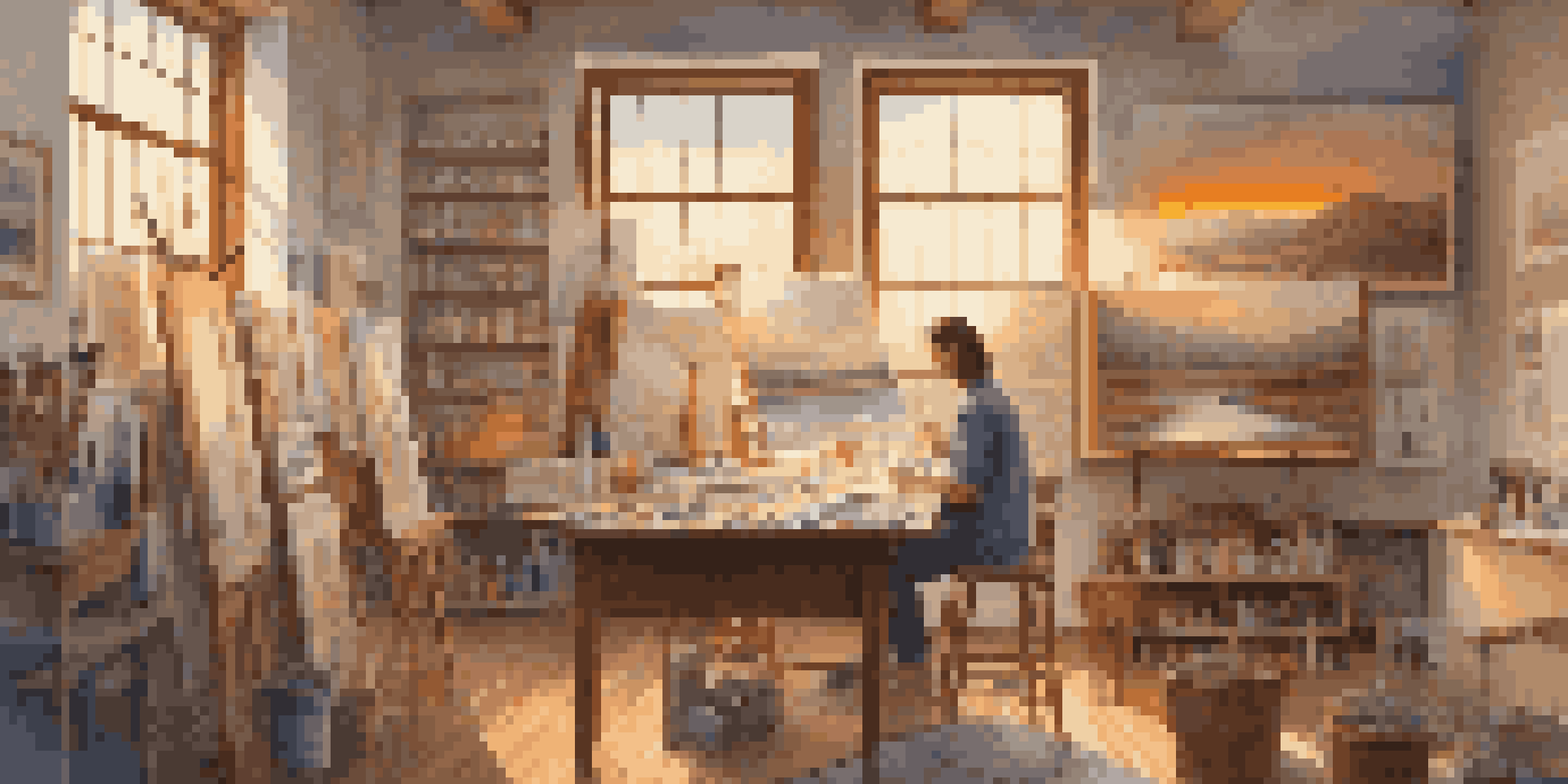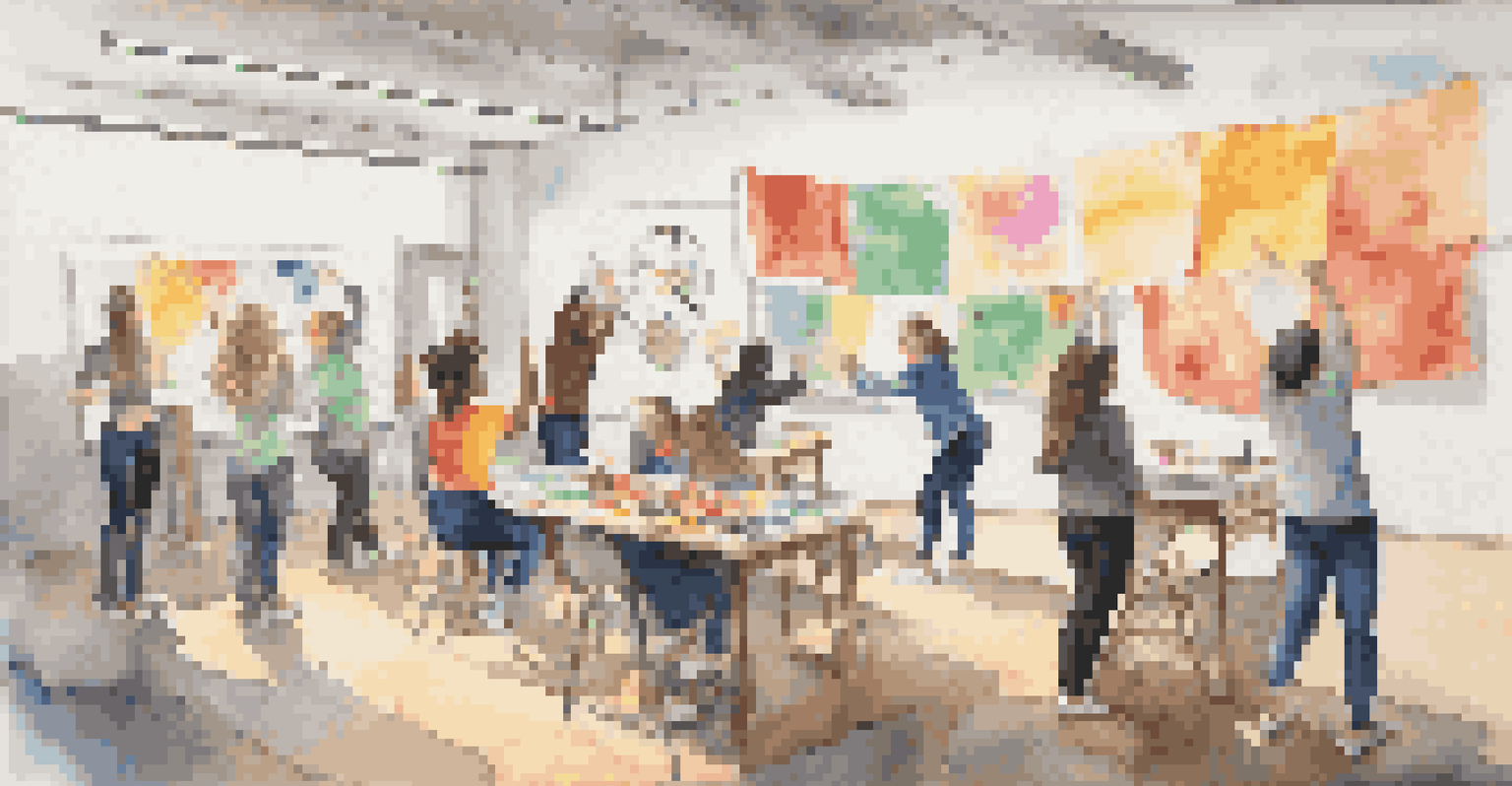Time in Art Education: Teaching the Concept Through Practice

Understanding the Concept of Time in Art Education
Time is a fundamental element in art education, influencing how students perceive and create art. It's not just about the physical passing of time; it's also about the concept of time as a narrative device, a medium, and even a theme in art. By exploring time, educators can help students understand how art evolves and how their own artistic practices can reflect different time periods.
Art is never finished, only abandoned.
For example, consider how the Impressionist movement captured fleeting moments in everyday life, emphasizing light and movement. Teaching students about this allows them to appreciate the historical context of artworks while also encouraging them to think about how they might express time in their own creations. This can lead to discussions about various artistic styles and how they relate to the concept of time.
Ultimately, grasping the importance of time in art helps students develop a deeper appreciation for both historical and contemporary works. It encourages them to reflect on their own experiences and how these moments can be expressed through art, fostering a more personal connection to their creative process.
Incorporating Time-Based Media in Art Curriculum
Integrating time-based media, such as video, performance, and installation art, can enrich the art curriculum significantly. These forms of art provide students with unique opportunities to explore the concept of time actively, allowing them to create works that unfold over a duration rather than in a single moment. Incorporating these media challenges students to think critically about how time can shape their artistic expression.

For instance, students can create time-lapse videos that showcase their artistic process, emphasizing how a piece evolves from start to finish. This not only teaches them technical skills but also encourages them to consider the viewer's experience of time as they engage with their work. The narrative of creation becomes an essential part of the artwork itself.
Time Shapes Artistic Expression
Understanding the concept of time enriches students' appreciation of art and encourages them to reflect on their own creative processes.
By embracing time-based media, educators can also foster collaboration among students, as they may work in groups to create performance art pieces that rely on timing and coordination. This collaborative aspect not only enhances their learning experience but also builds essential skills like communication and teamwork, preparing them for future creative endeavors.
Exploring Historical Contexts of Time in Art
Art does not exist in a vacuum; it's shaped by the historical and cultural contexts of its time. Educators can leverage this by guiding students through a timeline of art history, highlighting how different movements responded to the social, political, and technological changes of their eras. This exploration helps students understand how time influences artistic choices and the evolution of styles.
Time is what we want most, but what we use worst.
For example, looking at how the invention of photography in the 19th century impacted movements like Impressionism allows students to see the interconnectedness of art and technology. They can explore how artists adapted to new mediums and concepts of time, leading to the creation of entirely new forms of expression. This historical perspective can inspire students to think about how current events might influence their art today.
By framing art within its historical context, educators can encourage students to reflect on the significance of their own time. This connection fosters a sense of responsibility and awareness, prompting them to consider how their work might resonate with future generations, much like the artists of the past.
Using Timelines as a Tool for Artistic Development
Timelines can serve as a powerful tool for students to visualize their artistic journey and the evolution of their skills over time. By creating a personal timeline that documents their artistic growth, students can reflect on their experiences, challenges, and successes. This process not only reinforces their understanding of the concept of time but also encourages self-assessment and goal-setting.
For instance, students might mark significant projects, exhibitions, or influences on their timelines, allowing them to see how their work has evolved and what factors have contributed to their development. This reflective practice can help them identify patterns in their work and motivate them to pursue new directions or techniques.
Integrating Time-Based Media
Incorporating time-based media into the art curriculum allows students to explore artistic expression that unfolds over time.
Incorporating timelines into the curriculum also allows educators to highlight the importance of perseverance and resilience in the creative process. By celebrating milestones and acknowledging setbacks, students can better appreciate the non-linear journey of artistic growth, reinforcing the idea that time is an essential companion in their creative endeavors.
The Role of Time in Art Critique and Feedback
Time plays a pivotal role in the art critique process, influencing not only how artworks are evaluated but also how artists receive feedback. When critiquing art, it's essential to consider the time invested in the creative process, as this context can provide deeper insights into the work. Educators can teach students to appreciate the nuances of timing, both in the creation of their artwork and in the critique of others' pieces.
For example, during a critique session, students can discuss how the time spent on a project affected the outcome, prompting them to think critically about their artistic choices. This reflection can lead to more constructive feedback, as students learn to recognize and articulate the relationship between time and artistic intention. Encouraging this dialogue fosters an environment of mutual respect and collaboration.
Moreover, understanding the importance of time in critiques can help students develop patience and empathy, both for themselves and their peers. It promotes a culture where feedback is seen as a valuable learning opportunity rather than a judgment, creating a supportive atmosphere for artistic exploration and growth.
Encouraging Mindfulness and Presence in Artistic Practice
In today's fast-paced world, encouraging mindfulness in artistic practice can profoundly impact students' engagement with time. By fostering a sense of presence in the moment, educators can help students appreciate the creative process rather than rushing to complete a project. Mindfulness practices, such as meditation or focused breathing, can be incorporated into art sessions, allowing students to center themselves and connect deeply with their work.
For instance, a simple exercise could involve students spending a few minutes observing their surroundings before beginning a drawing. This practice helps them slow down, appreciate the details, and consider how time influences what they see. As they become more attuned to their environment, they may find new inspiration and insights that shape their artistic output.
Mindfulness Enhances Creativity
Encouraging mindfulness in artistic practice helps students engage more deeply with their work and appreciate the creative process.
Ultimately, embracing mindfulness in art education empowers students to value the journey of creation. It encourages them to invest time in their work, leading to more thoughtful, intentional pieces that reflect their unique perspectives and experiences.
The Future of Time in Art Education
As we look towards the future, the concept of time in art education will continue to evolve alongside technological advancements and societal changes. Educators must remain adaptable, exploring new ways to integrate time into the curriculum that resonate with today's students. This may involve incorporating digital tools or collaborative platforms that allow for innovative expressions of time in art.
For instance, virtual reality experiences could enable students to create immersive installations that manipulate time perception, offering a fresh perspective on the concept. As technology continues to shape how we interact with art, educators have the opportunity to inspire students to think beyond traditional boundaries and explore new dimensions of time in their work.

Ultimately, the future of time in art education is bright, filled with possibilities for creativity and exploration. By embracing these changes and encouraging students to engage with time in meaningful ways, educators can cultivate a new generation of artists who understand the profound impact of time on their creative journeys.